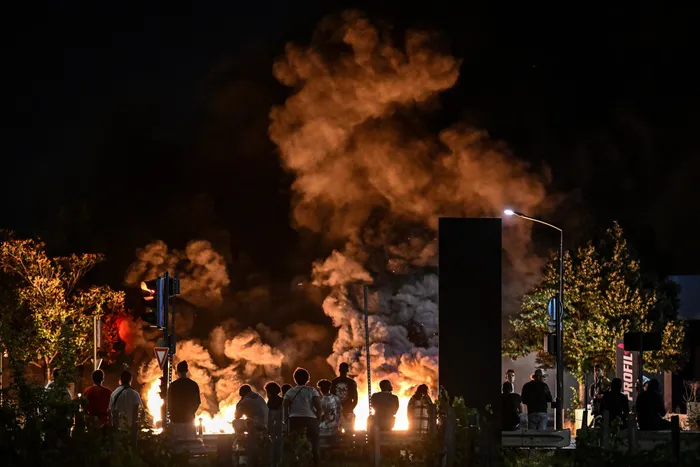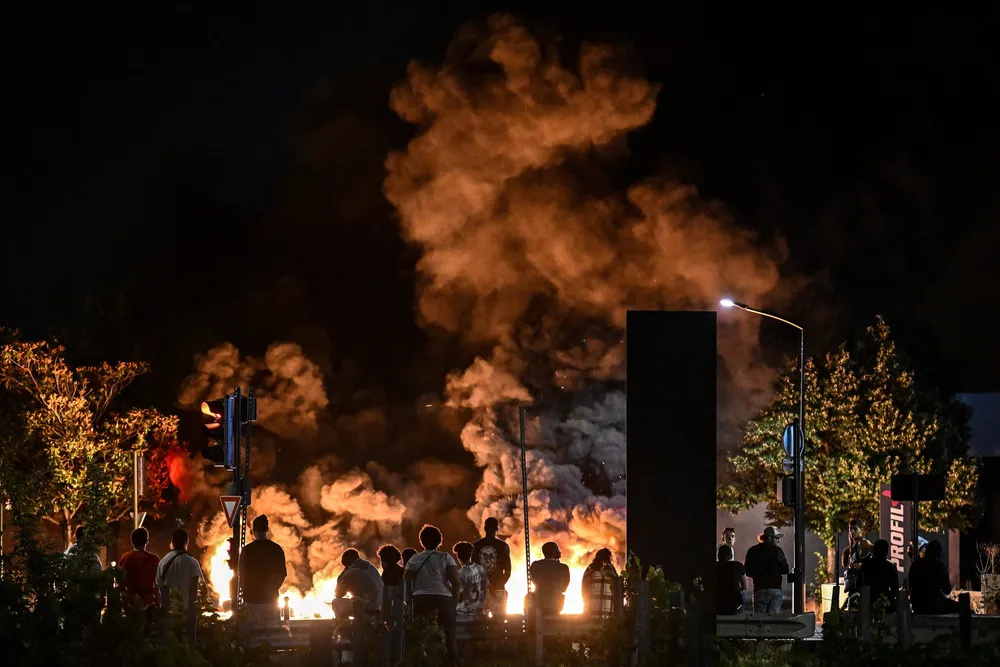French riots’ déjà vu raises the stakes for Macron

Picture: Philippe Lopez/AFP – People look at burning tyres blocking a street in Bordeaux, south-western France on late June 29, 2023, during riots and incidents nationwide after the killing of a 17-year-old boy by a police officer's gunshot following a refusal to comply in a western suburb of Paris.
Picture: Marco Bertorello/AFP – Spectators deploy a banner which reads ‘Justice for Nahel’ along the race route at the start of the 1st stage of the 110th edition of the Tour de France cycling race, 182 km departing and finishing in Bilbao, in northern Spain, on July 1, 2023. Clashes continued across France despite the 45,000 police officers deployed, the highest number of any night since the start of the protests, backed by light armoured vehicles and elite police units. Police made more than 1,000 arrests and the country braced for more riots ahead of the funeral of the 17-year-old teenager who was killed by a police officer.
By Lionel Laurent
A teenager killed by police in a Paris suburb. A wave of anger that morphs into widespread rioting and opportunistic looting. A tough law-and-order response followed by an appeal for unity and calm - and a political call for action that fades over time.
Such is the depressing “déjà vu” cycle of violence over the years in the French banlieues, captured in movies like “La Haine” and in news footage beamed around the world over the past week. These neighbourhoods built up to house immigrant workers in the 1960s and 1970s have become bywords for deprivation, ethnic conflict and military-style police tactics. And sadly, indifference.
It will take a lot of political willpower to make today’s cycle different from the last time violence flared up in 2005. The peak of rioting seems to have passed since a 45,000-strong deployment of law enforcement and Saturday’s funeral of French teenager Nahel, shot dead by a police officer on Tuesday. (Nahel’s last name wasn’t released by authorities because he was a minor). President Emmanuel Macron has scrapped a state visit to Germany, recognising this is no ordinary crisis: An estimated €100 million ($109 million) of damage has been dealt to stores, shopping malls, banks and more.
The omens aren’t great for change. Macron has no parliamentary majority and has lost political capital pushing through divisive flagship pension reform – which created its own extraordinary cycle of violence that also postponed a state visit, this time from King Charles.
Meanwhile, the far right – positioning itself as the party of law and order and small businesses – has never been more popular. It’s reminiscent of the political fallout of 2005, when tough-talking Interior Minister Nicolas Sarkozy built support for a presidential run by pledging to clean the “scum” from the streets.
An online survey by Le Figaro amid the riots showed far-right leader Marine Le Pen leading with 39 percent, six points ahead of Macron. The far left, which refused to call for calm, trailed. Macron’s former centre-right prime minister, Edouard Philippe, remains popular.

How did we get here, and what to do about it? There are two aspects to the violence that need addressing: One is the spark – in this case, the bullet that ended Nahel’s life – and the other a powder keg of resentment, under-education and unemployment.
On the spark, policing needs real change and would benefit from a more community-minded model. France is different from the US – it has less firearm use, a smaller prison population and a wider social safety net. Its problems stem from a lack of oversight and a disconnect from those it protects.
The force fails to police itself: A 2016 report found that in 59 cases of lethal force used over a six-year period, only two had led to a legal action. And guardrails on curbing gun use have been eroded over time, according to researcher Sebastien Roche of CNRS, the national research centre, citing an increase in deaths at police hands after a 2017 counter-terrorism law.
That so much policing in the banlieues (an outlying housing development in a French city, especially Paris) involves militarised crowd control and identity checks paradoxically speaks to an under-resourced, poorly trained force. Clichy-sous-Bois, epicentre of 2005 riots, had no police station until 2010 despite a higher crime incidence. Talk of colourblind republican values clashes with the evidence of numerous testimonials. Michel Zecler, a Black music producer who was badly beaten by police in his Parisian studio, told me in 2021: “Don’t tell me there’s no police racism after what I went through.”
As for the social powder keg, the ghettoisation of rich and poor in France has persisted even as income inequality is kept low by large-scale state redistribution. Access to public services is uneven: The flip side of police shortages in the banlieues are education shortcomings. Teachers turn over at a higher rate, and discrimination persists into employment. Paris has boomed while its environs have stagnated. Ali Rabeh, mayor of Trappes, calls it a “total failure of the republic”.
Inflation and covid-19 have made things worse. Dozens of local counsellors in May warned that the banlieues were in an emergency situation as higher building costs stalled vital renovation projects, rent payments went unpaid and uneven healthcare resources exposed by the pandemic had left scars. Regeneration is seen as key to better housing, quality of life and security; studies suggest these are neighbourhoods where people’s walking speed is double that measured in other, more pleasant towns.
Alexis de Tocqueville once wrote that every generation is a new people. The young age of rioters – average age of 17 – suggests a people in danger of being lost. The viral video of a father dragging his son from the streets at night and throwing him into the trunk of his car was a poignant reminder of the high number of single-parent families struggling to keep control. A woeful lack of day care in the area adds to families’ vulnerability; opening more kindergarten places was one of 31 ideas put forward by think tank Institut Montaigne last year to revive the banlieues.
There’s no magic bullet, and a lot of the violence will make some solutions even harder to accomplish – infrastructure for next year’s Olympic Games, seen as key to regenerating poor neighbourhoods, has been damaged. Macron is running out of time to keep his promises to the younger generation he claims to represent - and to avoid another case of urban violence déjà vu.
Lionel Laurent is a Bloomberg Opinion columnist covering digital currencies, the European Union and France. Previously, he was a reporter for Reuters and Forbes.
This column does not necessarily reflect the opinion of the editorial board or Bloomberg LP and its owners. This article was published in The Washington Post